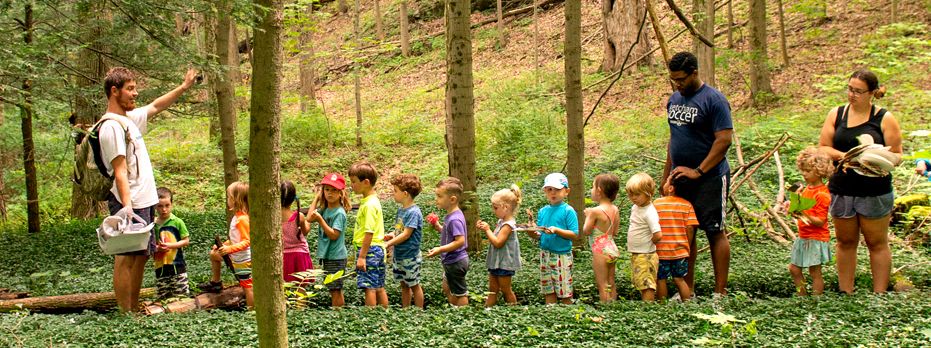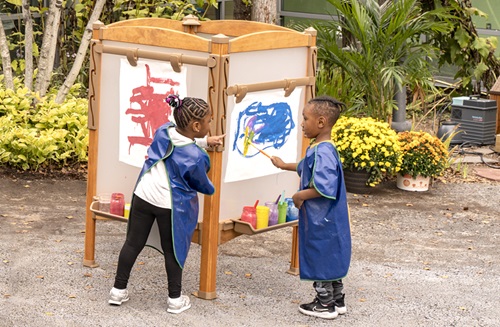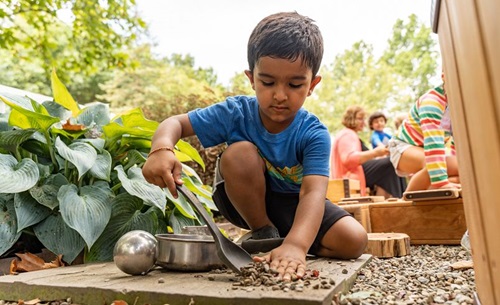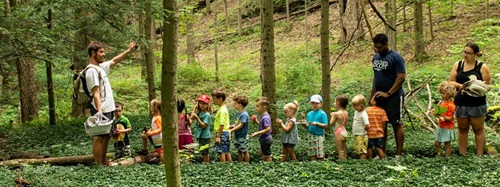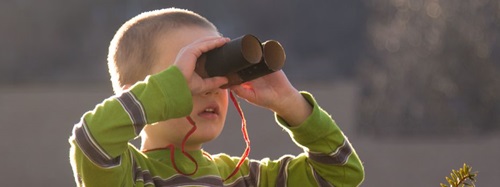Pollution, Preservation, and Ecology
Helping Young Children Learn About Renewable Resources
|
November 2008
“Why can’t we live like you did when you were small? Play in clean forests, fish in every lake, drink clean water straight from the stream?” (Gribble, 1994, p. 55).
—Statement by an elementary-age child read at the World Commission on Environment and Development, Bergen, Norway, 1990
As evidenced by the quote above, children around the world wish for a clean environment. As they mature, children begin to recognize environmental issues, and the role of humans in addressing these concerns. Yet what is the role for early childhood educators in addressing this concern? How do we talk about pollution, preservation, and ecology? In this article, we answer these questions and present research findings on children and the environment.
Definitions
Ecology, or the “pattern of relations between organisms and their environment” (Webster, 1979, p. 357) is a fundamental principle which applies to many topics. We can discuss ecology as it relates to renewal and recycling of manufactured materials, for example, and/or we can discuss ecology as it relates to the renewal and recycling of nature, including wildlife and human populations. To recycle means “to process in order to regain material for human use” (Webster, 1991, p. 985). To pollute is to “contaminate (an environment), especially with man-made waste” (Webster, 1991, p. 911). When we preserve, we “keep safe from injury, harm, or destruction” (Webster, 1991, p. 931), while conservation refers to the “careful preservation and protection of something; planned management of a natural resource to prevent exploitation, destruction, or neglect” (Webster, 1991, p. 279).
How Young Children Think About Ecology
Many educators are interested in discovering how children’s knowledge of pollution, preservation, and ecology unfolds. In general, we expect an understanding of this area to emerge parallel to the development of thought on other topics, although certain early childhood experiences might encourage interest in ecology. Kidd and Kidd (1997) examined the characteristics of 12 -to-16 year-olds who were active as volunteers at a wildlife museum in California.
Kidd and Kidd were interested in knowing what made these teens and pre-teens interested in ecological issues. To find out, the researchers interviewed all the volunteers over the telephone. Results showed that the volunteers had been exposed to and interested in wildlife issues at an early age. This exposure can include field trips or camping and owning and caring for a family pet. Thus, specific interest in ecology may be spawned by childhood experiences. At the same time, though, universal progressions in thought are developing over the course of childhood, as we can learn from Piaget.
Piaget’s Theory
One primary theory of how thought develops in young children was developed by Piaget (1926, 1936a, 1936b, 1969). Piaget was a stage theorist, which refers to a theorist who proposes a sequence of stages through which all children progress in the same order (Crain, 2000). The four stages Piaget proposed were:
- the Sensorimotor Stage (birth to two years of age);
- the Preoperational Stage (two to seven years of age);
- the Concrete Operational Stage (seven to 11 years of age);and
- the Formal Operational Stage (ages 11 and older).
According to Piaget, the thought processes of very young children are characterized by certain properties. Sensorimotor children process information primarily through their senses and motor movements (e.g., grasping and sucking).
By the preoperational stage (ages two to seven), children’s thought processes include symbols, (Crain, 2000) which are objects or actions that stand for something else. The thinking of preoperational children is still limited, however. Preoperational children cannot yet make mental transformations (manipulate objects, such as reversing a procedure, in one’s head), nor engage in abstract thought (deep connections among multiple ideas). Because some of the questions about pollution, preservation, and ecology are very abstract, we can introduce ecology to very young children, but we should not expect them to understand or grasp what the term means.
How Can I Introduce Ecology?
Research indicates the early childhood years are an important time for learning about the environment (Kidd & Kidd, 1997). While most of us recognize the futility of “teaching” advanced concepts to children who are not yet capable of understanding them, a curriculum can be centered around ecology in the early years. This curriculum is best focused on two objectives. First, what we will primarily be doing at this age is introducing concepts to children. This can occur in a variety of ways, including reading stories, talking about everyday occurrences, and bringing forward examples in creative and dramatic play. The second focus of our activities at this age can be modeling ecological practices for children (Kidd & Kidd, 1997; Wilson, 1993). This can occur through activities we engage in that children observe directly, by partnering with parents, and by establishing classroom procedures and practices that demonstrate a concern for the environment.
Research on Ecology and Children
Recent studies suggest young children are aware of and interested in environmental issues. Palmer (1994) interviewed 124 four-year-olds, and asked them questions about photographs of environmental issues. Topics covered in the interviews included “rain forests, deforestation/endangered species, global warming, and waste materials” (p. 205). Palmer was particularly interested in finding out how much the children knew about these topics, and whether their knowledge was superficial (at the surface), or whether it included a basic understanding of cause and effect. For example, a child might be able to identify that trees grow in a forest (superficial), but not understand the effect removing trees might have on the animals that live in the forest (cause and effect).
From the interviews, Palmer learned that most children were able to identify what was found in the photographs (e.g., trees, waste materials, snow). In addition, many of the children were able to describe what happens when the environment changes—indicating some understanding of cause and effect. About half of the children, for example, were able to describe what happened when trees were removed from an existing forest, and almost 90 percent were able to describe something that happened if snow (e.g., at the North Pole) became warmer.
In the Palmer study, one four-year-old gave this example of reasoning (prompted by a photograph of the rainforest): In response to the question, “Can you think of some…changes that might happen in the forest if the trees are cut down?,” the child said, “The animals live up on the trees and down on the trees…they won’t (if the trees went) have no houses…they would have no homes…and the sun can see them” (Palmer, 1994, p. 205, 209).
Another child noted, “They cut them up in logs…but if you cut too many, the world will die” (p. 209).
Implications
Based on the Palmer study and other studies in which researchers have asked children to engage in similar tasks, at least two implications for early childhood classrooms exist. First, it is critical that we take children outside to play and that we bring the outside world in (Cohen & Horm-Wingerd, 1993; Palmer, 1994; Tanner, 1980; Wilson, 1993). According to Palmer (1994), “The access of young people to the natural world outdoors is fundamental to the translation of knowledge into active concern for our world” (p. 211). The need for contact with the outdoors is highlighted by one author who estimated that we spend up to 95 percent of our lives indoors! (Cohen, 1988 in Wilson, 1993).
Secondly, we should offer children activities specifically designed to explore nature and the environment. These activities will help form the foundation for later, deeper understandings. Recycling, for example, is one area where children will construct a deeper understanding as they mature and have more experience. In the Palmer study, although 100 percent of the four-year-olds were able to identify the picture as one of waste materials, only eight percent currently demonstrated an understanding of what recycling exactly was. One child who did said, “We recycle so we can have some more paper…that saves trees” (p. 210).
Ecology Can Include Many Topics
Ecology, or the “pattern of relations between organisms and their environment” (Webster, 1979, p. 357) applies to many topics. In the early childhood classroom, we have the opportunity to be creative about how to introduce pollution, preservation, or ecology. One example is the environment, such as the beauty of clean air and water. All topics, if introduced, should be kept simple and should focus on the positive. We can introduce the importance of nature and outdoor spaces such as parks and gardens. We can also introduce ecology as it relates to the preservation of wildlife and endangered species, natural foods and fibers, the changing seasons, and/or the cycle from seed to harvest.
Classroom Ideas: Introduce Concepts
Again, a major focus in the early years will be to introduce concepts to children, with the expectation that children will only come to a full understanding as their thought processes mature. The introduction of pollution, preservation, and ecology itself is quite easy, and can occur in a variety of ways. Effective strategies include reading stories, talking about everyday occurrences, and bringing forward examples in creative and dramatic play. Many books about recycling and environmental issues are available as well. Environmental concepts can also be introduced into play and other classroom activities. We might have a “nature” corner or center where children can work on soil or water projects (with supervision!), or discover what happens when ice or snow melts. “To hold the children's interest, both the teacher and children should frequently add new items (to the center)” (Wilson, 1993, p. 17). Pollution, preservation, and ecology can also be introduced in dramatic play by including props used by gardeners, park rangers, and trash collectors, or by staging a “play” which includes these activities.
Like other topics, learning experiences related to ecology in our classrooms should include those which are child-led or child-initiated (Hendrick, 1997; Wilson, 1993). “For children, curiosity is the starting point of learning…curiosity provides the incentive to investigate the world” (Herman, Passineau, Schimpf & Treuer, 1991, p. 1). That is, we should strive to “set the stage” for learning, such as bringing in materials which will spark children's interest and curiosity. Materials we can bring in from nature include “bags of sand, driftwood, dried grasses, and pressed leaves” (Wilson, 1993, p. 18). Such active exploration is consistent with the ideas of Piaget, who felt children learned through interactions with their environment (Crain, 2000).
We can also introduce ecology through field trips and nature walks. A good place to start is the local park district, which often has information about nature trails, planned programs, and child-friendly exhibits in the area. Examples of typical and fun activities you might find are places where children can “trace” the tracks of various animals printed on the floor, or “practice” recycling by sorting materials (pretend or real).
Finally, we can also make use of daily routines to introduce concepts to children. We “teach” ecology when we have children help care for a classroom pet or plant, when we plant a garden and watch it grow together, or when we help children learn to turn off the faucet or recycle paper materials.
Model Concern for the Environment
A second way we can introduce pollution, preservation, and ecology to very young children is to serve as role models (Kidd & Kidd, 1997; Wilson, 1993). We do this when we show respect for the materials we use, such as rinsing paint brushes carefully or replacing the cap on the glue. We model an appreciation of nature when we stop to notice the leaves on a fall walk, or when we just talk about nature in positive terms. According to Wilson (1993), “Modeling conservation efforts and involving children in the process can have a positive impact on their lifelong attitudes and behaviors” (p. 19).
We can also practice good recycling habits in the classroom. We can practice recycling by separating paper from cans and plastic in trash. We can compost foodstuffs, when practical, and use recycled paper if possible and economical. We can make an effort to include reusable materials in the classroom, such as drawing with chalk on a slate rather than on construction paper. We can also model ecological principles for children by partnering with parents. Researchers suggest there are several ways to involve parents (Furman, 1990; Wilson, 1993), and that family involvement is linked to attitudes later in childhood (Eagles & Demare, 1999; Kidd & Kidd, 1997). We can share information directly, through parent newsletters—where we “teach” parents directly by writing about a topic or indirectly by offering activities to try at home. We can send books home with children, both stories (fiction) and those containing facts or activities (nonfiction). We can also invite parents to participate in nature activities at our school or centers, and encourage them to engage in such activities at home. And thirdly, we can enlist parent participation by having parents save boxes, containers, cartons, and other supplies for classroom projects and activities.
Emphasize the Positive
Be careful to approach pollution, preservation, and ecology from a positive angle rather than being overly negative or critical. As adults, it is easy for us to blame others for not doing enough or neglecting our natural resources. With young children, however, our goal should be introducing proactive and positive ways to improve the earth, rather than introducing the negative world of blame and doubt. Since preoperational children cannot distinguish reality from fantasy, we should be careful not to scare children with horror stories, scary information, or a sense of hopelessness about the earth.
Conclusion
So, what is the role for early childhood educators in addressing pollution, preservation, and ecology? In this article, we have explored possible answers to this question. Should we “teach” ecology to young children through flashcards, lectures, or tests? No. But what we should do is set the stage for children’s lifelong appreciation of preservation and ecology. Two ways to do this, as have been discussed here, are by: a) Introducing simple concepts in positive ways, and b) Modeling our own efforts to care for the world around us.
Used with permission from Early Childhood News.

